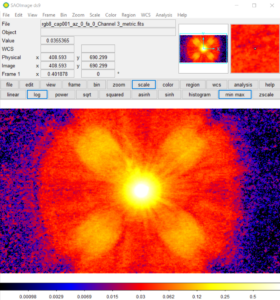Stray light (flare) documentation pages
Introduction: Intro to stray light testing and normalized stray light | Outputs from Imatest stray light analysis | History
Background: Examples of stray light | Root Causes | Test overview | Test factors | Test Considerations | Glossary
Calculations: Metric image calculations | Normalization methods | Light source mask methods
Instructions: High-level Imatest analysis instructions (Master and IT) | Computing normalized stray light with Imatest | Motorized Gimbal instructions
Settings: Settings list and INI keys/values | Configuration file input
Overview
Flexible Image Transport System (FITS) is a file format designed for the archival transport and storing of scientific data [1, 2, 3]. The FITS standard [4] is developed by the International Astronomical Union (IAU) FITS Working Group [5]. It may contain multi-dimensional arrays (1D vectors, 2D images, 3D+ data cubes), tables containing information, headers to provide descriptive information about the data, and supports compression of the aforementioned data.
Interacting with FITS Files
The FITS file format is commonly used within the astronomy community; therefore, many software tools/applications already exist for analyzing FITS file image data.
Viewers
NASA GSFC maintains a list of FITS viewers [6].
SAOImageDS9
SAOImageDS9 [7, 8] is one example of a commonly-used, free FITS file-viewing application. SAOImageDS9 is used by amateur and professional astronomers alike, for analyzing scientific image data such as from the James Webb Space Telescope (JWST).

A screenshot of the SAOImageDS9 application. A stray light metric image FITS file has been manipulated with logarithmic scaling and the “b” colormap to better reveal certain stray light artifacts.
I/O Libraries
NASA GSFC maintains a list of FITS I/O Libraries that work with many common programming languages [9].
References
[1] https://fits.gsfc.nasa.gov/
[2] https://en.wikipedia.org/wiki/FITS
[3] https://www.loc.gov/preservation/digital/formats/fdd/fdd000317.shtml
[4] FITS Standard Document. https://fits.gsfc.nasa.gov/fits_standard.html
[5] IAU FITS Working Group. https://fits.gsfc.nasa.gov/iaufwg/iaufwg.html
[6] FITS Image Software Packages. https://fits.gsfc.nasa.gov/fits_viewer.html
[7] Joye, W. A., & Mandel, E. (2003). New features of SAOImage DS9. In Astronomical data analysis software and systems XII (Vol. 295, p. 489).
[8] SAOImageDS9. https://sites.google.com/cfa.harvard.edu/saoimageds9
[9] FITS I/O Libraries. https://fits.gsfc.nasa.gov/fits_libraries.html

